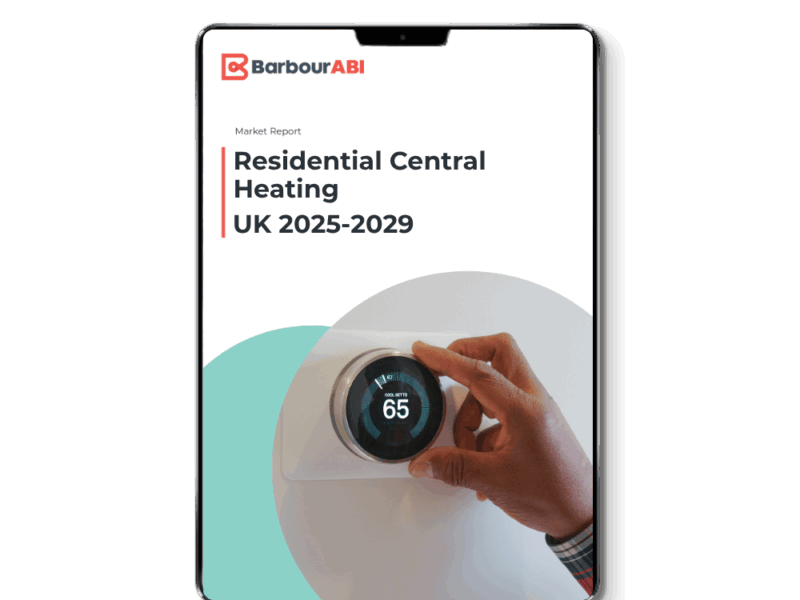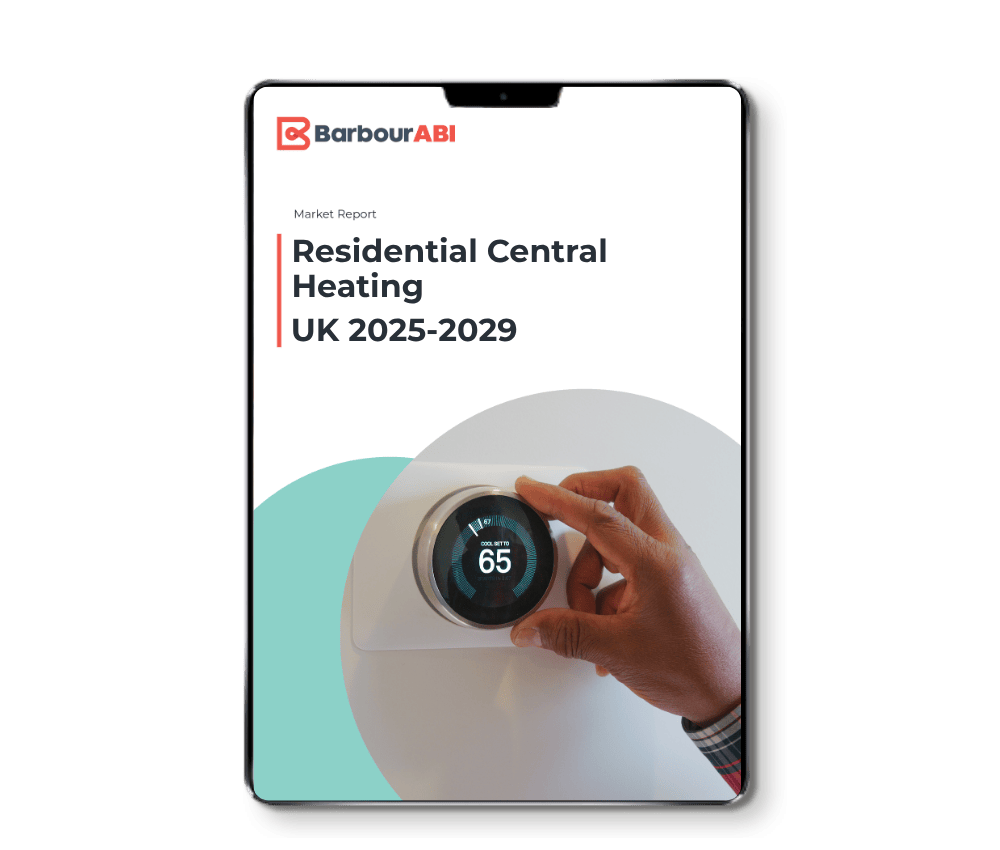Residential Central Heating Market Report UK 2025-2029
Available as an Instant Download PDF
The 17th edition of the Residential Central Heating Market Report reviews the UK residential heating market and assesses developments within the overall market as well as the individual sub-sectors. Aspects examined include market size, trends and influences, market prospects, major suppliers, and key distribution channels. It contains historical data for the 2020-2024 period and provides forecasts to 2029.
£1,499.00 Exc. VAT
Market Summary
The UK residential central heating market has experienced sluggish trading conditions in recent years, reflecting a slowdown in housebuilding activity and economic challenges. However, some areas such as heat pumps and heating controls, have seen continued growth.
The forthcoming Future Homes Standard and the UK’s broader Net Zero agenda are expected to significantly influence this market, particularly by promoting a shift from fossil fuel boilers to low-carbon heating systems.
Market Analysis
The UK residential central heating market is heavily influenced by construction activity. RMI activity has the greatest influence on market growth and depends on consumer confidence and levels of disposable income. With the UK having amongst the oldest housing in Europe, the ongoing requirement to upgrade the housing stock also continues to drive market demand.
The new housebuilding sector is expected to play an increasingly important role in central heating demand, especially for low-carbon heating systems, amid the government’s increased efforts to accelerate housebuilding and higher energy efficiency requirements in the Future Homes Standard.
Forecast
Growth prospects for the UK residential central heating market are expected to be positive over the next five years, showing steady growth as economic conditions improve. By 2029, the market is expected to be worth around £2bn at MSP, with a compound annual growth rate of 7.4% (CAGR 2024-2029), driven by legislative changes and forecast trends in UK construction activity.
The implementation of the FHS will see a shift away from fossil fuel boilers towards low-carbon heating systems in new builds in England, with air source heat pumps expected to be the preferred technology. Other segments of the central heating market, such as smart heating controls and low temperature radiators, are also anticipated to benefit from the introduction of the FHS.
Key Companies by Product Type
Boilers
The UK market for residential boilers is dominated by four leading players – Worcester Bosch Group, Vaillant Group UK, Ideal Boilers and Baxi Heating.
Radiators
The UK market for residential radiators is relatively concentrated with the leading players identified as Stelrad, Purmo Group UK, Zehnder Group UK and Pitacs.
Heating Controls
The leading players in the UK market for conventional heating controls are Danfoss, Siemens, Honeywell, Drayton Controls, Secure Meters. Salus Controls and the TFC Group.
The leading players in the UK market for smart heating controls are Hive Active Heating and Google Nest 3rd Generation.
Heat Pumps
Daikin is a key player in the supply of air source heat pumps, followed by companies such as Nibe, Samsung, Vaillant, Viessmann and Grant Engineering. Other suppliers include Hitachi (Yutaki products) and Bosch Thermotechnology.
Table of Contents
INTRODUCTION
1.1 Context
- 1.2 Definition
- 1.2.1 Boilers and circulators
- 1.2.2 Radiators
- 1.2.3 Heating controls
- 1.2.4 Heat pumps
- 1.3 Abbreviations
2 MARKET SUMMARY
- 2.1 Market size (value)
- 2.1.1 Market overview
- 2.2 Imports and exports
- 2.3 Market penetration
- 2.4 Market mix by type of fuel
- 2.5 Market mix by product category
3 MARKET INFLUENCES AND DRIVERS
- 3.1 Main market influences and drivers
- 3.2 Political influences and drivers
- 3.3 Economic influences and drivers
- 3.4 Social influences and drivers
- 3.5 Technological influences and drivers
- 3.6 Legal influences and drivers
- 3.7 Environmental influences and drivers
4 END USE SECTORS
- 4.1 End use sector mix
- 4.2 Residential new build housing
- 4.2.1 New work output
- 4.2.2 Starts and completions
- 4.2.3 Mix of housing completions
- 4.3 Residential RMI
- 4.3.1 RMI output
- 4.3.2 House moving activity
- 4.3.3 First time installations
5 MARKET SUB SECTORS
- 5.1 Boilers and circulators – market size (value)
- 5.1.1 Boiler and circulators – market overview
- 5.1.2 Boilers – market mix by type of fuel
- 5.1.3 Boilers – market mix by installation position
- 5.1.4 Circulators – market mix by product category
- 5.1.5 Boilers and circulators – suppliers / key players
- 5.1.6 Boilers – market shares and company profiles
- 5.1.7 Circulators – market shares and company profiles
- 5.2 Radiators – market size (value)
- 5.2.1 Radiators – market overview
- 5.2.2 Radiators – market mix by product category
- 5.2.3 Radiators – market mix by type of material
- 5.2.4 Radiators – suppliers / key players
- 5.2.5 Radiators – market shares and company profiles
- 5.3 Heating controls – market size (value)
- 5.3.1 Heating controls – market overview
- 5.3.2 Conventional heating controls – market mix by product category
- 5.3.3 Smart heating controls – market mix by product category
- 5.3.4 Heating controls – suppliers / key players
- 5.3.5 Conventional heating controls – market shares and company profiles
- 5.3.6 Smart heating controls – market shares and company profiles
- 5.4 Heat pumps – market size (value)
- 5.4.1 Heat pumps – market overview
- 5.4.2 Heat pumps – market mix by product category
- 5.4.3 Heat pumps – suppliers / key players
- 5.4.4 Heat pumps – company profiles
6 DISTRIBUTION
- 6.1 Market map
- 6.2 Channel shares by supplier
- 6.3 Key company profiles
- 6.3.1 Plumbers’ merchants
- 6.3.2 Electrical wholesalers
- 6.3.3 Home improvement multiples
- 6.3.4 Online retailers
- 6.3.5 Direct supply
- 6.3.6 Plumbing & heating contractors
7 MARKET FORECASTS
- 7.1 Ten-year market view 2020 – 2029
- 7.1.1 Overall market – forecast
- 7.1.2 Boilers and circulators
- 7.1.3 Radiators – forecast
- 7.1.4 Heating controls – forecast
- 7.1.5 Heat pumps – forecast
- 7.2 UK residential central heating market – prospects and influences
- 7.2.1 Overall market
- 7.2.2 Boilers and circulators
- 7.2.3 Radiators
- 7.2.4 Heating controls
- 7.2.5 Heat pumps
8 SOURCES OF INFORMATION
Tables and Charts Included
Chart 1: UK Residential Central Heating Market by Value 2020 – 2025 (£m at MSP)
Chart 2: Residential Construction New Orders by Value 2020 – 2024 (£m at current prices)
Table 3: Imports and exports of boilers 2020 – 2024 (£m)
Table 4: Imports and exports of glandless impeller pumps 2020 – 2024 (£m)
Table 5: Imports and exports of radiators 2020 – 2024 (£m)
Table 6: Imports and exports of heat pumps* 2020 – 2024 (£m)
Chart 7: UK Residential Central Heating Installations by Tenure 2024 (% share by volume)
Chart 8: UK Households with Central Heating Installed by Boiler Type 2024 (000s)
Chart 9: UK Market Mix by Household Fuel Type 2024 (% share by volume)
Chart 10: UK Residential Central Heating Market by Product Category 2024 (% share by value)
Table 11: UK Residential Central Heating Market by Product Category 2024 (£m at MSP)
Table 12: UK Residential Central Heating Market PESTLE Summary 2025
Table 13: Medium term economic forecasts 2025 – 2029 (published May 2025)
Table 14: UK Underfloor Heating Market by Value 2020 – 2024 (£m at MSP)
Table 15: Part L Residential Central Heating Criteria
Chart 16: UK Residential Central Heating Market Mix by End Use Sector 2024 (% share by value)
Chart 17: Residential Housing New Work Output by Value 2020 – 2024 and 2025-2029 forecast (£bn)
Table 18: Residential New Build Starts and Completions 2020 – 2024 (000’s) Chart 19: Residential Housing RMI Output by Value 2020 – 2024 and 205-209 forecast (£bn)
Table 20: UK Residential Property Transactions Valued at £40k or Above 2020 – 2025
Chart 21: UK Market for Residential Boilers and Circulators by Value 2020 – 2025 (£m at MSP)
Chart 22: Residential Boilers Market Mix by Product Category 2024 (% share by volume)
Chart 23: Residential Boilers Market Mix by Type of Fuel 2024 (% share by volume)
Table 24: Boiler Upgrade Scheme by Status and Technology Type May 2022 – March 2025
Chart 25: Residential Circulators Market Mix by Product Category 2024 (% share by volume)
Table 26: Residential Boiler Suppliers Market Shares 2024 (% share by value)
Table 27: Bosch Thermotechnology Ltd
Table 28: Vaillant Group UK Ltd
Table 29: Ideal Boilers Ltd
Table 30: Baxi Heating UK Ltd
Table 31: Alpha Therm Ltd
Table 32: Residential Circulator Suppliers Market Shares 2024 (% share by value)
Table 33: Grundfos Pumps Ltd
Table 34: Wilo (UK) Ltd
Chart 35: UK Market for Residential Radiators by Value 2020 – 2025 (£m at MSP)
Chart 36: Residential Radiators Market Mix by Product Category 2024 (% share by value)
Table 37: Residential Radiators Suppliers Market Shares 2024 (% share by value)
Table 38: Stelrad Ltd
Table 39: Purmo Group (UK) Ltd
Table 40: Zehnder Group UK Ltd
Table 41: Pitacs Ltd
Table 42: Kudox Ltd
Chart 43: UK Market for Residential Heating Controls by Value 2020 – 2025 (£m at MSP)
Chart 44: UK Market for Residential Heating Controls 2020 – 2029 (£m at MSP)
Chart 45: Conventional Heating Controls Market Mix by Product Category 2024 (% share by value)
Table 46: Conventional Heating Controls Product Function by Type
Table 47: Smart Heating Controls Product Function by Type
Table 48: Conventional Heating Controls Market Shares 2024 (% share by value)
Table 49: Danfoss Ltd
Table 50: Honeywell Control Systems Ltd Table 51: Aalberts Integrated Piping Systems Ltd
Table 52: Salus Controls Plc
Table 53: Secure Meters UK Ltd
Table 54: Schneider Electric Controls Ltd
Table 55: Smart Heating Controls Market Shares 2024 (% share by value)
Table 56: Heatmiser UK Ltd
Table 57: Green Energy Options Ltd
Chart 58: UK Market for Heat Pumps by Value 2020 – 2025 (£m at MSP)
Chart 59: Heat Pump Sales by Volume 2020 – 2024
Table 60: Supported Heat Pump Installations by Government Scheme 2018 – 2025
Chart 61: Residential Heat Pumps Market Mix by Product Category 2024 (% share by volume)
Table 62: Residential Heat Pumps Leading Suppliers 2024
Table 63: Daikin Airconditioning UK Ltd
Table 64: Nibe Energy Systems Ltd
Table 65: Viessmann Ltd
Table 66: Grant Engineering UK Ltd
Table 67: Kensa Group Ltd
Table 68: Glen Dimplex UK Ltd
Chart 69: Distribution Structure for Residential Central Heating Products
Chart 70: Residential Central Heating Market Distribution by Channel 2024 (% share by value)
Table 71: Travis Perkins Trading Company Ltd
Table 72: Wolseley UK Ltd
Table 73: UK Plumbing Supplies Ltd
Table 74: City Plumbing Supplies Holdings Ltd
Table 75: Stark Building Materials UK Ltd
Table 76: Screwfix Direct Ltd
Table 77: B&Q Ltd
Table 78: Wickes Building Supplies Ltd
Table 79: HHGL Ltd (Homebase)
Table 80: UK Plumbing & Heating Contractors by Number of Employees 2020 and 2024
Table 81: UK Residential Central Heating Market by Value 2020 – 2029 (£m at MSP)
Table 82: UK Market for Residential Boilers and Circulators by Value 2020 – 2029 (£m at MSP)
Table 83: UK Market for Residential Radiators by Value 2020 – 2029 (£m at MSP)
Table 84: UK Market for Residential Heating Controls by Value 2020 – 2029 (£m at MSP)
Table 85: UK Market for Residential Heat Pumps by Value 2020 – 2029 (£m at MSP)
The following PESTLE highlights summarises the main factors that influence and drive the UK residential central heating market in 2025:
Political
Key influences include government policies and progress towards achieving net zero emissions by 2050, as well as housing policies and available government incentives and grants.
Economic
Sluggish economic growth, weak consumer confidence, and a slowing housing market have negatively impacted demand in recent years. Economic conditions are expected to start improving from 2026.
Social
Trends affecting the sector include changes in buying habits, increased awareness of home energy usage and energy efficiency, evolving home design trends, growth in underfloor heating systems, and demographic shifts that affect the availability of skilled labour.
Technological
There are ongoing innovations in heating technologies across product sectors and a growing adoption of renewable energy and smart AI technologies.
Legal
Legal factors impacting the residential central heating sector include updates to Building Regulations, the Future Homes Standard, the Clean Heat Market Mechanism, and relaxed planning rules for air-source heat pumps.
Environmental
The sector is influenced by the development of renewable technologies, Environmental Product Declaration (EPD) certification, sustainable production methods, and the impacts of climate change.
Product Category
For the purpose of this report, the UK residential central heating market concerns wet central heating systems and covers boilers, circulators, radiators, heating controls and heat pumps.
Sector Analysis
This report focuses mainly on central heating systems in residential applications.
Distributor Analysis
There are various routes to market in the Residential Central Heating market, which is segmented by:
- Direct Sale
- Specialist Distributor
- Plumber’s Merchant
- Electrical Wholesalers
- Online Retailers
- Home Improvement Multiples
- Housebuilder
End Use Analysis
Analysis by New Build Housing, Replacement and First Time Installation.

Paired Report Discount
Save £250 for every two reports you buy
Discount applied in basket
Frequently bought together

Trusted by industry leaders
For more detailed requests speak to our research experts directly
By using this form you agree that your data will be processed and protected in line with our Privacy Policy.
Research you can depend on
Our reports go deeper to give you the insights needed to make your next strategic move.
- Detailed assessment of the market – analysis of the market structure and recent developments within the market.
- Market prospects up to 4 years – market value, opportunities, impact of socioeconomic events and regulatory developments.
- Detailed information – market size, influences, market factors and key players.
- Analysis by product group – market size, product mix, sector trends etc.





